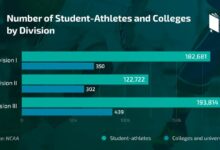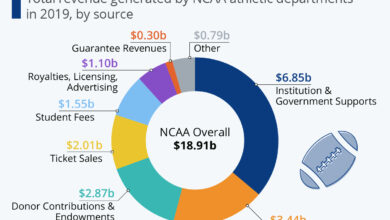College Scholarships For Sports: A Game-Changing Opportunity For Student-Athletes
College scholarships for sports offer a transformative opportunity for student-athletes to pursue their athletic and academic dreams simultaneously, opening doors to a brighter future filled with potential and possibilities. As the spotlight shines on these scholarships, let’s delve into the intricacies and advantages they bring to aspiring young athletes.
Overview of College Scholarships for Sports
College scholarships for sports play a crucial role in supporting student-athletes as they pursue their academic and athletic goals. These scholarships provide financial assistance to help offset the costs of attending college while allowing athletes to continue competing at a high level.
Types of Sports Scholarships
- Athletic Scholarships: Awarded based on athletic ability and performance in a particular sport.
- Merit-Based Scholarships: Awarded for academic achievement, leadership, and other non-athletic factors.
- Need-Based Scholarships: Awarded based on financial need, regardless of athletic or academic performance.
Statistics on Student-Athletes Receiving Scholarships
According to the NCAA, only a small percentage of high school athletes receive a full-ride scholarship to compete in college sports. In fact, less than 2% of high school athletes are awarded scholarships to NCAA Division I schools. However, there are opportunities for partial scholarships and financial aid available to a larger number of student-athletes across all divisions.
NCAA Scholarships
When it comes to college scholarships for sports, the NCAA (National Collegiate Athletic Association) is a major player in providing opportunities for student-athletes to pursue their academic and athletic goals simultaneously. Let’s dive into the details of NCAA scholarships and what student-athletes need to know.
Scholarship Opportunities by NCAA
- The NCAA offers scholarships to student-athletes competing in various sports across different divisions.
- These scholarships can cover tuition, fees, room and board, and other expenses related to attending college.
- Student-athletes can receive full or partial scholarships based on their athletic abilities and the specific rules of each division.
Eligibility Criteria for NCAA Scholarships
- Student-athletes must meet academic eligibility requirements set by the NCAA, including maintaining a minimum GPA and completing required high school courses.
- Athletes also need to meet amateurism rules and be registered with the NCAA Eligibility Center.
Comparison of NCAA Divisions I, II, and III Scholarships
- NCAA Division I schools offer the most scholarships and are typically the most competitive in terms of athletic talent.
- Division II schools provide scholarships as well, but with fewer full-ride opportunities compared to Division I.
- Division III schools do not offer athletic scholarships but may provide other forms of financial aid based on need or merit.
Application Process for NCAA Scholarships
- Student-athletes need to work closely with their high school coaches and the NCAA Eligibility Center to ensure they meet all requirements and deadlines.
- They must also reach out to college coaches, attend showcases, and create a recruiting profile to increase their visibility to potential scholarship programs.
Tips for Student-Athletes to Increase Chances of Receiving NCAA Scholarships
- Focus on academics in addition to athletics to meet eligibility requirements and stand out to college coaches.
- Stay proactive in the recruiting process by reaching out to coaches, attending camps, and showcasing your skills in competitions.
- Seek guidance from your high school or club coaches on the best strategies for securing scholarship opportunities.
Academic Requirements for Maintaining NCAA Scholarships
- Student-athletes must maintain a certain GPA and make satisfactory progress towards their degree to retain their NCAA scholarships.
- Failure to meet academic standards can result in the loss of scholarship funding and eligibility to compete.
Role of Coaches in Helping Student-Athletes Secure NCAA Scholarships
- Coaches play a crucial role in connecting student-athletes with college programs, providing recommendations, and advocating for their athletes’ skills and abilities.
- They can guide athletes through the recruiting process, help them navigate scholarship offers, and support their academic and athletic development.
NAIA Scholarships
When it comes to college scholarships for sports, the NAIA (National Association of Intercollegiate Athletics) also offers a variety of scholarship options for student-athletes. These scholarships provide opportunities for athletes to continue their athletic careers while pursuing higher education.
Unlike NCAA scholarships, NAIA scholarships are offered by smaller colleges and universities that are members of the NAIA. While NCAA schools are typically larger institutions with more strict academic requirements, NAIA schools may have more flexibility in their admissions criteria and scholarship offerings.
Differences between NAIA and NCAA scholarships
- NAIA scholarships are offered by smaller colleges and universities, while NCAA scholarships are offered by larger institutions.
- NAIA schools may have more flexibility in their admissions criteria and scholarship offerings compared to NCAA schools.
- NAIA scholarships may be based more on athletic ability and potential rather than strict academic requirements.
Benefits of pursuing NAIA scholarships
- Opportunity to continue playing sports at the college level while pursuing a degree.
- Potential for more scholarship opportunities, as NAIA schools may have a smaller pool of student-athletes competing for scholarships.
- Flexibility in admissions criteria, which can benefit student-athletes who may not meet the strict academic requirements of NCAA schools.
Athletic Scholarship Application Process
When it comes to applying for athletic scholarships, there are specific steps and requirements that student-athletes need to follow. This process can be competitive, so it’s essential to understand what is needed to enhance your chances of securing a sports scholarship.
Steps in Applying for Athletic Scholarships
- Research potential colleges and their athletic programs to find the best fit.
- Reach out to coaches and express your interest in their program.
- Prepare and submit required documents, such as academic transcripts, athletic resumes, and recommendation letters.
- Complete and submit the Free Application for Federal Student Aid (FAFSA) for financial aid consideration.
- Attend any tryouts or recruitment events as needed.
Required Documents for Scholarship Applications
- Academic transcripts showcasing your GPA and standardized test scores.
- Athletic resume highlighting your sports achievements, positions played, and awards received.
- Letters of recommendation from coaches, teachers, or other mentors.
- Personal statement or essay outlining your passion for the sport, your goals, and why you deserve the scholarship.
Tips for Enhancing Scholarship Applications
- Showcase not only your athletic skills but also your academic achievements and leadership qualities.
- Highlight any community service or volunteer work you have done.
- Stay organized and meet all application deadlines.
- Seek feedback on your application materials from mentors or coaches.
Importance of Academic Standing
Maintaining good academic standing is crucial when applying for athletic scholarships. Many programs have academic eligibility requirements that student-athletes must meet to be considered for scholarships. Your academic performance can also impact your overall college experience and future opportunities.
Sample Timeline for Scholarship Applications
| Months Before College | Tasks |
|---|---|
| 12-18 Months | Research colleges and athletic programs. |
| 6-12 Months | Reach out to coaches and express interest. |
| 3-6 Months | Prepare and submit application materials. |
Role of Letters of Recommendation
Letters of recommendation from coaches or teachers can strengthen your sports scholarship application by providing insights into your character, work ethic, and potential as a student-athlete. These letters offer a personal perspective that complements your academic and athletic achievements.
Academic Requirements for Sports Scholarships
Academic performance plays a crucial role in securing sports scholarships as colleges and universities often look for well-rounded student-athletes who can excel both on the field and in the classroom.
Importance of Academic Performance
A strong GPA and good standardized test scores are key factors that college coaches and recruiters consider when awarding sports scholarships. Academic success demonstrates discipline, dedication, and the ability to balance athletic and educational commitments.
GPA and Standardized Test Scores
- GPA and standardized test scores are used to assess a student-athlete’s academic potential and eligibility for scholarships.
- Most colleges and athletic associations have minimum GPA requirements for sports scholarships, with higher GPAs increasing the likelihood of receiving financial aid.
Strategies for Academic Eligibility
- Student-athletes should prioritize academics by staying organized, managing their time effectively, and seeking help when needed.
- Setting academic goals, creating study schedules, and maintaining open communication with teachers can help student-athletes stay on track academically.
GPA Requirements Comparison Table
| Sports Scholarship | Minimum GPA Requirement |
|---|---|
| NCAA Division I | 2.3 GPA |
| NCAA Division II | 2.2 GPA |
| NAIA | 2.0 GPA |
Improving GPA for Scholarships
- Attend study groups, seek tutoring, and meet with teachers for extra help in challenging subjects.
- Develop good study habits, stay organized, and prioritize assignments and studying over other activities.
- Take challenging courses, maintain a consistent study schedule, and set academic goals to improve GPA.
A real-life success story showcases how dedication to academics can open doors to sports scholarships. John Smith, a talented basketball player, improved his GPA from 2.5 to 3.5 by seeking tutoring and prioritizing his studies. His academic success not only made him eligible for a full scholarship but also paved the way for a successful college career.
Skill Development and Recruitment
Developing strong skills in your chosen sport is crucial when it comes to attracting scholarship offers from colleges and universities. College recruiters look for athletes who not only excel in their sport but also show potential for growth and improvement.
Importance of Skill Development
Before diving into the recruitment process, it’s important to focus on honing your skills. College coaches seek out athletes who demonstrate talent, dedication, and coachability. By continuously working on improving your skills, you not only increase your chances of getting noticed by recruiters but also show your commitment to your sport.
Recruitment Process for Student-Athletes
Recruitment for sports scholarships can vary depending on the sport and the division level of the college or university. Coaches often attend tournaments, showcases, and high school games to scout potential recruits. It’s essential to be proactive in reaching out to coaches, creating a standout athletic profile, and showcasing your skills through videos and game footage.
Tips for Showcasing Skills to Recruiters
- Attend sports camps and showcases where college coaches will be present.
- Create a highlight reel showcasing your best plays and skills.
- Keep your athletic profile updated with current stats, achievements, and academic information.
- Reach out to college coaches via email or phone to express your interest in their program.
- Stay in touch with coaches and provide updates on your progress and achievements.
Financial Aid Options for Student-Athletes
Student-athletes have various financial aid options available to help support their education while pursuing their athletic careers. It is crucial for student-athletes to explore and consider combining scholarships with other forms of financial aid to maximize their funding opportunities.
Types of Financial Aid for Student-Athletes
- Athletic Scholarships: These are awarded based on athletic ability and performance in a particular sport.
- Academic Scholarships: Students can also qualify for academic scholarships based on their academic achievements.
- Grants: Grants are typically need-based financial aid that does not have to be repaid.
- Work-Study Programs: Student-athletes can participate in work-study programs to earn money while in school.
Significance of Combining Scholarships with Other Forms of Financial Aid
Combining scholarships with other forms of financial aid can help student-athletes cover the full cost of their education. By leveraging various funding sources, student-athletes can reduce their out-of-pocket expenses and minimize student loan debt.
Resources for Additional Funding Opportunities
- Financial Aid Offices: Student-athletes can consult with their college’s financial aid office to explore additional funding opportunities.
- Private Scholarships: There are numerous private scholarships available for student-athletes based on various criteria such as academic achievements, community involvement, and leadership skills.
- Athletic Organizations: Student-athletes can also check with athletic organizations and foundations related to their sport for scholarship opportunities.
Scholarships for Specific Sports
When it comes to scholarships for specific sports, there are various opportunities available for athletes looking to further their education while continuing to excel in their chosen sport. From popular sports like basketball, football, and soccer to niche sports, there are scholarships tailored to different athletic abilities and interests.
Popular Sports Scholarships
- Basketball: Basketball scholarships are highly competitive, with many colleges and universities offering full-ride scholarships to top players. These scholarships often require a high level of skill and dedication to the sport.
- Football: Football scholarships are also in high demand, especially at the NCAA Division I level. These scholarships can cover tuition, room and board, and other expenses for student-athletes.
- Soccer: Soccer scholarships are available at both the NCAA and NAIA levels, with opportunities for talented players to receive financial aid based on their skills on the field.
Specialized Scholarships for Niche Sports
- Golf: Golf scholarships are available for both men and women, with opportunities to compete at the collegiate level while receiving financial assistance for tuition and other expenses.
- Swimming: Swimmers can also find scholarships at colleges and universities, with some institutions offering scholarships specifically for competitive swimmers who excel in the pool.
- Tennis: Tennis scholarships are available for talented players who demonstrate exceptional skill and potential in the sport. These scholarships can help cover the costs of attending college while continuing to compete at a high level.
Impact of Sports Scholarships on College Decisions
Sports scholarships play a significant role in influencing student-athletes’ college decisions. These scholarships can offer financial assistance and the opportunity to continue playing a sport at a competitive level while pursuing higher education. However, committing to a college for a sports scholarship comes with its own set of benefits and challenges.
Benefits and Challenges of Committing to a College for a Sports Scholarship
When student-athletes choose a college based on a sports scholarship, they can alleviate the financial burden of tuition and other expenses. This can open doors to higher education that may have otherwise been out of reach. Additionally, sports scholarships provide the opportunity to compete at a collegiate level, enhancing athletic skills and offering exposure to potential career opportunities in sports.
On the flip side, committing to a college for a sports scholarship may come with the pressure to perform both academically and athletically. Balancing rigorous training schedules with academic responsibilities can be challenging and may require excellent time management skills. Additionally, student-athletes must consider the commitment to the team and the expectations that come with representing their college in sports competitions.
Stories of Student-Athletes Making College Decisions Based on Sports Scholarships
- Alex, a talented soccer player, received a full scholarship to a Division I university. Despite offers from other schools, he chose this college due to their strong soccer program and the financial support provided by the scholarship. This decision allowed him to pursue his passion for soccer while obtaining a quality education.
- Emily, a track and field athlete, faced a tough decision between a Division II college offering a partial scholarship and a Division III college with no athletic aid. After weighing her options, she chose the Division II college as the scholarship helped lessen the financial burden on her family, and she valued the competitive opportunities at that level.
Scholarship Renewal and Retention
When it comes to college sports scholarships, it’s essential for student-athletes to understand the requirements for renewal each year. Maintaining academic and athletic performance is crucial to retaining the scholarship throughout college.
Requirements for Scholarship Renewal
Each year, student-athletes must meet specific criteria to renew their sports scholarships. These criteria typically include maintaining a certain GPA, participating in team activities, and meeting any other obligations set by the scholarship provider.
Factors Leading to Loss of Sports Scholarships
- Decline in academic performance
- Violation of team rules or code of conduct
- Failure to meet NCAA or NAIA eligibility requirements
Tips for Maintaining Scholarships
- Stay on top of academics and maintain a good GPA
- Communicate openly with coaches and support staff
- Continue to work hard and improve your skills
- Adhere to team rules and guidelines
- Seek help or support when needed, both academically and athletically
Scholarships for Female Athletes
When it comes to scholarships for female athletes, there are various opportunities available across different sports. Female student-athletes have the chance to secure funding for their education while pursuing their passion for sports.
Availability of Scholarships in Underrepresented Sports
Female athletes in underrepresented sports like lacrosse, field hockey, and gymnastics can find scholarships specifically tailored to support their athletic endeavors. These scholarships aim to encourage participation and excellence in sports that may not receive as much attention as others.
Impact of Title IX on Women’s Sports Scholarships
Title IX has played a significant role in the increase of funding and opportunities for female athletes. This legislation has helped level the playing field by ensuring that women have equal access to sports scholarships, leading to more opportunities for female student-athletes.
Opportunities in Various Sports
- Female athletes can secure scholarships in sports such as soccer, basketball, track and field, and swimming.
Enhancing Scholarship Applications
Female athletes can enhance their scholarship applications by showcasing leadership skills, community involvement, and academic achievements. Highlighting these aspects can make their applications stand out and increase their chances of securing scholarships.
Importance of Academic Performance
It is crucial for female athletes to maintain a strong academic record alongside their athletic performance to be eligible for sports scholarships. Academic excellence is often a key criterion considered by scholarship committees when making their decisions.
Scholarships for Underrepresented Sports
When it comes to scholarships for athletes, underrepresented sports often face challenges in terms of funding and recognition. In this section, we will explore the current landscape of scholarships tailored for athletes in underrepresented sports and ways to enhance opportunities in this area.
Current State of Scholarship Opportunities for Underrepresented Sports
Scholarships for underrepresented sports are crucial in providing support and recognition to athletes in lesser-known disciplines. While popular sports like basketball and football receive significant scholarship attention, other sports such as fencing, rowing, or rugby may struggle to secure adequate funding for athletes.
- There are specific scholarships offered by organizations like the Women’s Sports Foundation or the National Federation of State High School Associations that cater to athletes in underrepresented sports.
- Recommendations for improvement include increasing visibility for underrepresented sports, establishing mentorship programs, and creating more scholarship opportunities through partnerships with corporate sponsors.
Key Organizations Supporting Scholarships for Underrepresented Sports
Several key organizations play a vital role in supporting scholarships for athletes in underrepresented sports:
| Organization | Impact |
|---|---|
| Women’s Sports Foundation | Empowers female athletes in various sports through scholarship programs. |
| National Collegiate Athletic Association (NCAA) | Offers scholarships for a wide range of sports, including underrepresented disciplines. |
Eligibility Criteria and Application Process Comparison
When comparing scholarships in popular sports versus underrepresented sports, differences in eligibility criteria and application processes become apparent:
- Popular sports scholarships may have more stringent requirements due to high competition, while underrepresented sports scholarships might focus more on passion and dedication rather than prior achievements.
- The application process for underrepresented sports scholarships may involve showcasing unique skills and experiences that set athletes apart from the crowd.
Effectiveness of Scholarships in Promoting Diversity and Inclusion
Data analysis can shed light on the effectiveness of scholarships in promoting diversity and inclusion in sports:
Research shows that scholarships for underrepresented sports lead to increased participation from diverse backgrounds and contribute to a more inclusive sporting environment.
Athlete Perspectives on Scholarships in Underrepresented Sports
Interviews with athletes and coaches involved in underrepresented sports provide valuable insights into the importance of scholarships in their field:
- Athletes often express gratitude for scholarship opportunities that enable them to pursue their passion and compete at higher levels.
- Coaches emphasize the role of scholarships in attracting talent and fostering growth in underrepresented sports.
Balancing Athletics and Academics
Balancing academics and athletics is a crucial aspect of a student-athlete’s life. It requires proper time management, goal setting, and support from coaches and teachers to excel in both areas effectively.
Daily Routines for Effective Time Management
- Establish a daily schedule that includes dedicated time for studying, attending classes, training, and rest.
- Use a planner or digital calendar to organize tasks and prioritize assignments based on deadlines and importance.
- Limit distractions during study sessions and practice to maximize productivity.
- Incorporate short breaks between study sessions to avoid burnout and maintain focus.
Benefits of Setting Academic and Athletic Goals
- Setting short-term academic goals helps student-athletes stay focused and motivated to complete assignments and improve grades.
- Long-term athletic goals provide direction and purpose, guiding student-athletes towards success in their sports endeavors.
- Achieving academic and athletic goals instills a sense of accomplishment and boosts confidence in student-athletes.
Examples of Successful Student-Athletes
- Simone Biles – Olympic gymnast who balanced rigorous training schedules with online education to graduate high school.
- Alex Morgan – Professional soccer player who pursued a degree in Political Economy while competing at the highest level.
Role of Coaches and Teachers in Supporting Student-Athletes
- Coaches can help student-athletes create realistic schedules, monitor academic progress, and provide mentorship on balancing priorities.
- Teachers play a vital role in accommodating student-athletes’ training and competition schedules by offering flexibility and academic support.
- Collaboration between coaches and teachers ensures that student-athletes receive the necessary guidance to excel in both academics and sports.
Comparison Chart: Student-Athletes vs. Regular Students
| Aspect | Student-Athletes | Regular Students |
|---|---|---|
| Time Commitment | Training sessions, competitions, and travel | Class attendance, study sessions, and extracurricular activities |
| Pressure | Performance expectations in sports and academics | Academic performance and social expectations |
| Support System | Coaches, teammates, teachers | Teachers, classmates, family |
Alumni Support and Networking
Alumni support and networking play a crucial role in assisting student-athletes who have received scholarships. By connecting with alumni, student-athletes can benefit from mentorship, career guidance, and valuable connections in their chosen field.
Benefits of Alumni Networking
- Access to job opportunities and internships
- Mentorship and guidance from experienced professionals
- Potential sponsorships and endorsements
- Networking for future collaborations and projects
Success Stories from Alumni Connections
Many student-athletes have successfully leveraged their alumni connections to secure employment opportunities, internships, and even start their own businesses. These connections have opened doors that may not have been possible without the support of alumni networks.
Engaging with Alumni Networks
- Attend alumni events related to your field of study or career interests
- Reach out to alumni through social media platforms like LinkedIn
- Participate in mentorship programs offered by alumni associations
- Stay in touch with alumni through periodic updates on your achievements and progress
Building Meaningful Connections with Alumni
Ask alumni about their career trajectory, seek advice on navigating the industry, and express gratitude for their support and guidance.
Showcasing Skills and Achievements to Alumni
- Create a professional portfolio highlighting your accomplishments
- Share success stories from your athletic and academic journey
- Seek feedback and input from alumni on ways to enhance your skills and marketability
Closing Summary
In conclusion, College scholarships for sports not only pave the way for athletic success but also serve as a stepping stone towards higher education and personal growth. They embody the fusion of talent and dedication, shaping the future of student-athletes in a profound and impactful manner.









